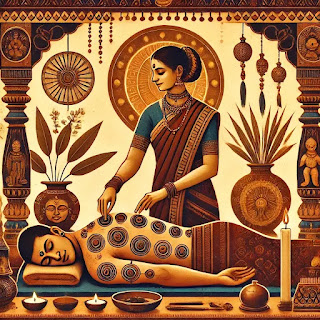Varmam therapy, an integral part of the Siddha system of medicine, has recently garnered significant attention after the National Institute of Siddha (NIS) achieved a Guinness World Record by providing Varmam therapy to 567 individuals simultaneously. This remarkable accomplishment has not only highlighted the therapeutic potential of Varmam but also shed light on the ancient healing practices rooted in India’s rich cultural heritage. In this article, we will explore Varmam therapy, its origins, applications, and how it has adapted to modern healthcare needs.

What is Varmam Therapy?
Varmam therapy is a unique and traditional healing method within the Siddha medical system. Practiced predominantly in Tamil Nadu, India, it is revered for its effectiveness in alleviating musculoskeletal pain, neurological disorders, and injuries. Varmam therapy involves the manipulation of vital energy points, known as ‘Varmam points,’ located throughout the human body. These points are strategically positioned where life force, or ‘Prana,’ converges and controls the body’s physiological and psychological functions.
Historical Significance
The origins of Varmam therapy trace back to ancient Tamil literature, with references in texts like ‘Siddha Maruthuvam’ and ‘Thirumoolar Thirumanthiram.’ Traditionally, Varmam was practiced as both a therapeutic and a martial art technique, known as ‘Varmakalai.’ This dual purpose highlights the versatile nature of Varmam, where it served as a form of defense while also being a profound healing practice.
Applications and Benefits of Varmam Therapy
One of the most compelling aspects of Varmam therapy is its wide range of applications. It is particularly renowned for providing rapid relief from the following conditions:
Musculoskeletal Pain: Including back pain, joint pain, and muscle spasms.
Neurological Disorders: Such as stroke recovery and nerve dysfunction.
Trauma and Injury Recovery: Especially effective for sports injuries and accidents.
Chronic Ailments: Including arthritis and degenerative diseases.
Modern Relevance and Scientific Backing
Despite its ancient roots, Varmam therapy has gained credibility in modern times through scientific validation. Research has demonstrated its efficacy in reducing inflammation, promoting blood circulation, and enhancing musculoskeletal health. The integration of Varmam with contemporary physical therapy and rehabilitation practices has opened new avenues for holistic patient care.
The Role of the National Institute of Siddha (NIS)
The National Institute of Siddha, established in 2005 in Tambaram, Chennai, operates under the Ministry of AYUSH. It plays a pivotal role in promoting Siddha medicine and Varmam therapy by conducting research, providing education, and offering healthcare services. The institute’s recent Guinness World Record achievement underscores its commitment to preserving and promoting traditional medical practices.
FAQs about Varmam Therapy
What is Varmam therapy, and how does it work? Varmam therapy involves manipulating specific points on the body to regulate energy flow, providing relief from pain and enhancing healing.
Is Varmam therapy scientifically proven? Yes, several studies have indicated its effectiveness in pain management and rehabilitation.
Can Varmam therapy be combined with modern treatments? Yes, it is often used alongside physical therapy and rehabilitation to improve outcomes.
Are there any side effects? When practiced by trained therapists, Varmam therapy is generally safe with minimal side effects.
Who can practice Varmam therapy? Only trained practitioners with knowledge of Siddha medicine and human anatomy should perform Varmam therapy.
Conclusion
Varmam therapy continues to evolve as a valuable practice in both traditional and modern healthcare contexts. Its recognition by institutions like NIS and its integration with contemporary treatments reflect its enduring relevance. As research continues to unfold its potential, Varmam therapy remains a beacon of India’s ancient healing wisdom, adaptable to modern healthcare challenges.
